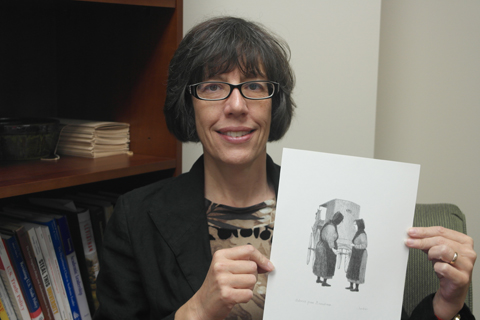Pin-up girls or women embodying FDR’s Four Freedoms worth fighting for—World War II poster girls had little control in propaganda, said Dr. Katherine Jellison, Professor and Interim Chair of History, at a recent conference at Lancaster University in the United Kingdom on “Lessons of War: Gender History and the Second World War.”
Jellison gave a paper on “Peculiar Poster Girls: Images of Pacifist Women in American World War II Propaganda,” based on her research for a book she is writing on old order Amish in Lancaster County, PA, during the Great Depression and World War II.
In her paper, Jellison acknowledged that the nation’s propaganda machine produced numerous images of scantily clad models and actresses intended to appeal to the heterosexual male gaze and inspire young men to vanquish the enemy and return to the pleasures of home. Not all propaganda that focused on the female body, however, did so with the intention of appealing to young men’s sexual desires.
Jellison’s paper drew attention to a lesser known category of images that appealed to the patriotism of wartime servicemen and home-front civilians alike by focusing on the female body enacting the Four Freedoms President Roosevelt told Americans they were fighting to protect: Freedom of Speech, Freedom of Religion, Freedom from Fear, and Freedom from Want.
Photographers working for the government’s Office of War Information (OWI) scoured the countryside looking for women who seemed to embody these ideals in their daily lives. Among those they chose as their subjects were the Amish and Mennonite farm women of Lancaster County. But these war propaganda photos were steeped in irony: The Amish and Mennonite women who appeared in them were members of religious sects who strongly opposed armed conflict.
The OWI’s presentation of Amish and Mennonite women demonstrates in dramatic fashion the extent to which women—whether they be pin-up girls or pacifists—lacked control over the ways in which their bodies were used and displayed in wartime propaganda.




















One Comment